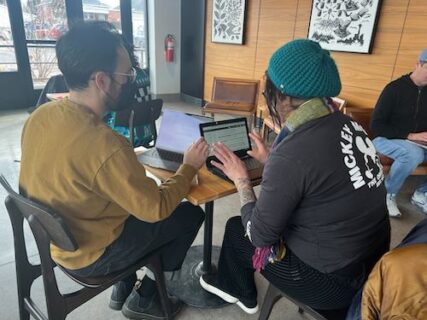How to adapt usability testing to fit the needs of your project
At the Center for Civic Design we do all kinds of usability testing. We test devices, forms and websites related to elections and run tests with voters, non-voters, elections offices and experts.
Usability testing is one of the best ways to make sure voters understand the voter journey, whether it’s a form they have to fill out or a website with essential information. Along the way, we’ve learned a lot about how to adapt a test to fit the needs of an individual project. After all, every usability test is different: audience, purpose, and the format of what you are testing all need to be considered when designing a test. Here are some highlights of what we’ve learned in our own work and some tips that have made our testing more effective. We hope these tips can help you conduct your next usability test.

Meet people where they already are
As we plan a usability test, we start by thinking about how to meet people where they are. We are looking for places to meet an appropriately diverse group of people.
Meeting people where they are could mean going to community spaces or connecting with organizations about whether they can help us identify places and people for the testing. Recruiting people online using Facebook or Craigslist can also be a way to reach a wide audience, but also keep in mind that this method will exclude people who don’t use the internet in this way (or at all).
When we begin a research project, we consider how we can meet people with different experiences of voting and civic engagement.
Here are some places to consider for testing:
- Your county office building or service center. We’ve had great results setting up a table or “working the line” in larger offices.
- Libraries are one of our favorite locations because so many different kinds of people use them.
- Community centers are often a good place to find people who speak different languages or are from a specific area in your county.
Decide how you will test
Consider whether you will be testing on paper, on a screen, or some other way. Most election information and forms are available both on paper and on the web, so you can choose which version to use when testing.
Paper works well for static information, but for forms – especially ones with multiple steps – it’s great to test on a computer. You could use a laptop or a table, but it’s worth making sure that everyone will know how to interact with the computer. For example, track pads on a laptop can be hard to use for someone with little experience with them.
“We wanted to make sure that the device wasn’t going to interfere with what we were trying to test,” Sean, a researcher at CCD, explained. When it comes to technology, we’ve found more people had an easier time with the touch feature on a screen than other devices.
Ask people to “think out loud”
Usability testing is about learning how the user navigates through a form or a website. We tell people at the start of a session that we are testing the design not the people we work with. During a usability test you to see what kinds of problems people have so you can fix them and improve the experience.
One of the ways to understand the experience is to ask people to talk about what they are seeing and what they are doing in real-time. It’s a way of learning more because they are narrating their experience as they happen.
A related challenge is that people may ask you for help during the test. After all, you are from the elections office! And you may spend most of your time actually assisting voters.
Just remember that the whole point of usability testing is to find out how easy it is to use. You won’t find out if a form is self-explanatory if you rush in with an explanation.
Further reading on usability testing
Field guide on testing ballots for usability
Talking to strangers on the street: recruiting through intercepting people by Dana Chisnell for User Experience Magazine
What can you learn from usability testing in the civic space?
Usability matters – even with paper ballots
This was originally published in our Civic Designing newsletter. Subscribe on Mailchimp to get election design tips delivered to your mailbox.

